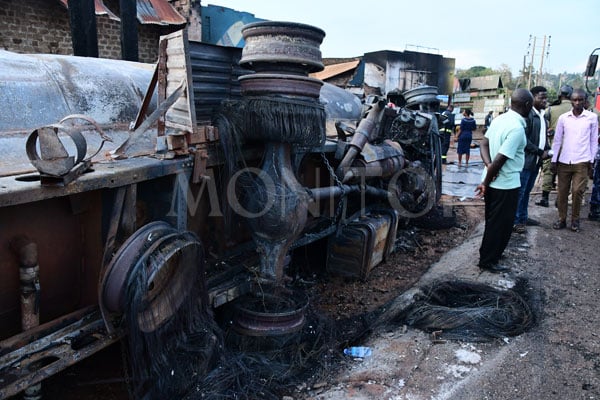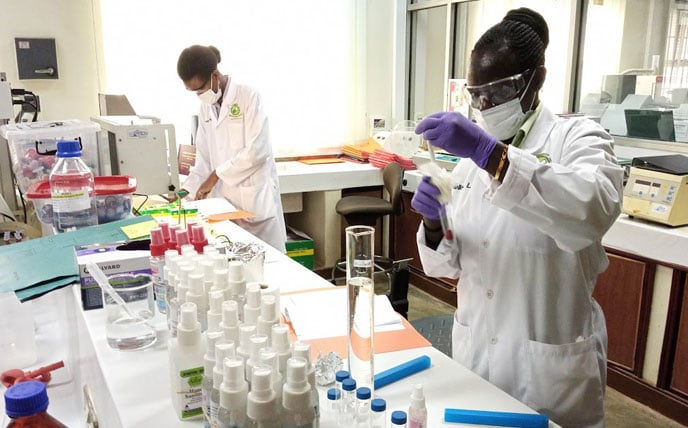Lamwo health facility where 16 staff serve 200,000 locals

The Relief, Disaster Preparedness, and Refugees Minister, Mr Hillary Onek (second left); the Japanese Deputy Ambassador, Mr Yoshimura Tomotaka (centre); the Lamwo Woman MP, Ms Nancy Acora Odonga (second right) and Ms Juliana Lunguzi, the programme coordinator at UNFPA (right) cut a ribbon during the commissioning of a new theatre
What you need to know:
- The theatre and other technical units at the facility only run for two days a week due to lack of personnel, equipment and medical supplies
Health workers at Palabek-kal Health Centre IV in Palabel-kal Sub-county, Lamwo District, are struggling to provide medical services to a population of about 200,000 people comprising South Sudanese refugees and the host community.
The Monitor has learnt that the facility only has 16 health workers, with a single medical doctor. A fortnight ago, Health ministry officials accompanied by the Relief, Disaster-preparedness and Refugees minister, Mr Hillary Onek, were at the facility to officiate over its upgrade from health centre III to a health centre IV.
Whereas the refurbishment and upgrade of the facility is meant to improve the quality of maternal and child health services, Dr Patrick Kijumi, the officer in charge, said they are overwhelmed. Dr Kijumi said while the facility now has a theatre and other technical units, they only run for two days a week due to lack of personnel, equipment and medical supplies.
“Because we have a lot of patients who need these services, we will be working Tuesdays and Thursdays. We have a very good infrastructure, but the equipment is not there and the drugs are lacking, especially the essential ones, we need the equipment, medicines and the rest, we cannot run without them,” he said in an interview.
“Nowadays, medicine and supplies are also lacking because we are still being supplied at the level of a Health Centre III and that means for procedures performed at the health centre IV level such as surgeries, we lack the essential medicines and other materials,” Dr Kijumi added.
According to the district health officer, Dr Denis Ocula Omoya, both drug sup- plies and staffing at Palabek-kal Health Centre IV stand at 12 percent.
“Aware that the facility is located in a town council (Palabek-kal) and the upgrade will see numbers double or triple, it means we have to establish a proper waste management system to handle the huge volume of waste,” Dr Ocula added.
A health centre IV is supposed to serve a population of 100,000 people. During the commissioning ceremony of the facility last weekend, Dr Peter Mukobi, the director of Gulu Regional Referral Hospital, said: “We still have a long way to go because access is not yet good and we need to add another health centre IV to ensure equitable and quality health service delivery in this area with a huge number of refugees.”
Mr Thomas Ndyanabo, the International Rescue Committee (IRC) team leader for Lamwo District, said the upgrade of the facility will cut their referral distances from nearly 80km to only 25km.
“For the last month alone, we had 164 referrals to Kitgum Hospital and Padibe Health Centre IV whose distances are more than 75km. At least for now, Kal upgrade brings better services closer since it is only 25km from the settlement,” he stated.
“This will reduce our operations costs significantly because of the shorter distance. IRC provides primary health care services at Palabek refugee settlement from Paluda Health Centre III, Awic Health Centre III and Akuru Health Centre III in Lamwo District which currently hosts 84, 723 South Sudanese refugees,” he added.
Ms Juliana Lunguzi, the sexual reproductive health integration officer and programme coordinator at UNFPA, said with support from the Japanese government, they constructed and equipped the facility’s theatre, as well as refurbished the general facility.
“We procured all the equipment to the tune of $2.5 million, including training of the staff, to run it, we also refurbished the health facility and supported the training of midwives,” Ms Lunguzi added.
Dr Richard Mugahi, the commissioner for Reproductive, Maternal and Child Health at the Health Ministry, in an interview stated that an arrangement has been reached to borrow medical supplies from health facilities across the region with extra stock of drugs to deliver to the facility.
“In the meantime, I have arranged with Gulu Regional Referral Hospital that we are going to get you drugs from across the region to support this health facility and its theatre to continue working as a health Centre IV,” he said.
According to Dr Mugahi, proper supplies of drugs will normalise at the facility in July 2025. The Ministry of Health is set to supply the health centre with more equipment for the theatre and laboratory, including 20 beds for the maternity and children’s units.
Mr Onek said a budget has been secured for the next DRDIP project to provide more services at the health facility.
“We got funds from the World Bank under DRDIP to help in elevating the standard of the facility next year to provide facilities like the cold room to keep dead bodies, to improve the theatre and also sanitation,” he stated.




